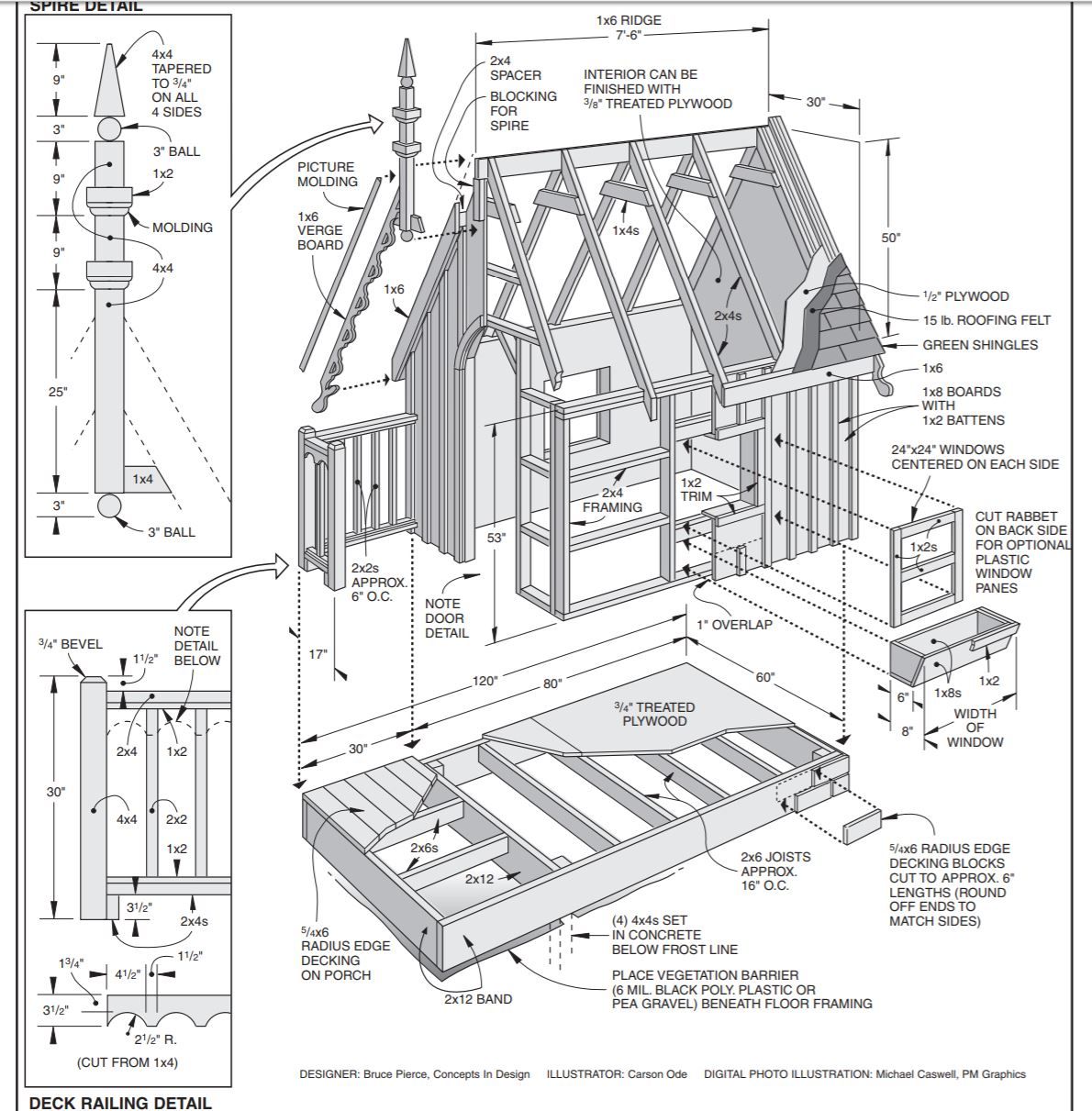
August 11, 2025 – A stunningly intricate architectural plan for a garden shed or playhouse has been inspiring builders and homeowners online, evoking the charm of a storybook cottage. With its steep, dramatic roof, ornate spire, and detailed custom woodwork, it represents the pinnacle of backyard craftsmanship—a project that promises to be a cherished landmark in any garden.
This design is, without question, a showcase for the art of carpentry. However, its immense beauty and complexity come with a significant challenge. The very thing that makes it so special—its intricate, layered woodwork—also makes it highly vulnerable to the elements and creates a demanding long-term maintenance commitment. The biggest mistake a potential builder can make is to fall in love with the fairytale look without understanding the real-world effort required to keep the magic alive.
Step 1: A Showcase of Master Carpentry
To understand the challenges, we must first appreciate the incredible level of detail and skill this design requires. This is not a simple weekend project; it’s a piece of heirloom-quality construction.
- The Dramatic Roofline: The structure is defined by its steep, Gothic-inspired roof. It is crowned with a decorative spire and finial and trimmed with an ornate 1×6 Barge Board featuring elegant Picture Molding. This creates a powerful, vertical emphasis that is both dramatic and whimsical.
- Custom Posts and Railings: The porch posts are not standard lumber but custom-turned pieces featuring decorative 3″ Ball details. The Deck Railing is a complex assembly of beveled caps, multiple rail sizes, and detailed connections, requiring precise joinery.
- Textured Siding and Trim: The walls are clad in a traditional board-and-batten style, creating rich shadow lines. The windows are framed with multiple layers of trim to add visual depth.
- A Solid Foundation: Even with all its decorative flair, the structure is built on a solid pier foundation, with the plan correctly specifying that the 4x4s [be] set in concrete below [the] frost line to ensure stability in cold climates.
This is a project designed to test and showcase a carpenter’s skill.
Step 2: The Critical Mistake – Underestimating Wood’s Worst Enemy
The fundamental mistake in approaching a project like this is underestimating the relentless effect of water on complex wood joints.
- The Problem: A Thousand Places for Water to Hide. Every decorative element, layered piece of trim, and intricate joint creates a potential trap for moisture. Water can seep into the end grain of the railing pieces, get caught on the ledges of the window trim, and work its way behind the battens on the siding. Unlike a simple, flat surface that sheds water easily, this design has hundreds of small crevices where water can linger.
- The Inevitable Result: Wood Rot. Trapped moisture is the primary cause of wood rot and fungal growth. The beautiful, crisp edges of the decorative details can soften, discolor, and begin to decay, especially in the areas most exposed to rain and splash-back from the ground. Maintaining the protective layer of paint and caulk on such a complex surface is a formidable task.
- The Constant Maintenance Burden: A standard shed might need a new coat of paint every 5-7 years. A structure like this requires a much more vigilant and laborious maintenance schedule. To prevent rot, every single joint and seam must be regularly inspected, re-caulked, and touched up to ensure the wood remains perfectly sealed from the elements. It becomes a permanent, ongoing chore.
[Image showing a close-up of peeling paint and rotted wood on an exterior window trim]
Step 3: The Modern Correction – The Look Without the Labor
Fortunately, modern building science offers a way to achieve this highly ornate look without the high-maintenance drawbacks of traditional wood.
- The Magic of Composite Materials: The key to a durable “storybook” shed is to substitute traditional lumber with modern, weather-proof materials for the most exposed and intricate parts.
- Cellular PVC Trim: This material is a game-changer. It looks, feels, and can be cut and painted exactly like wood, but it is 100% waterproof. It will never rot, swell, warp, or be eaten by insects. It is the perfect material for creating the intricate railings, the ornate barge boards, and all the layered window and door trim.
- Fiber Cement Siding: The board-and-batten look can be perfectly replicated using durable fiber cement panels and trim strips. Fiber cement is impervious to water, rot, pests, and is also fire-resistant.
- Composite Decking: The porch floor can be built with modern composite decking, which resists fading and decay and requires no seasonal sealing.
By using these advanced materials for the “pretty” parts, a builder can use standard, pressure-treated wood for the hidden structural frame and create a building that combines timeless style with 21st-century durability.
Conclusion: Fusing Fairytale Style with Modern Reality
“A project like this isn’t just a building; it’s a piece of outdoor furniture, and it demands the same level of care as a fine wooden boat,” says Frank Davies, a (fictional) veteran contractor. “The mistake people make is thinking they can build it with standard lumber from a big-box store and then forget about it. Water is relentless, and it will find a way in.”
“For most people who love this aesthetic but don’t want the full-time job of maintaining it, the new PVC and composite materials are the answer,” he adds. “You get all the charm and the intricate detail, but the material itself does the hard work of fighting off the weather.”
This beautiful design is a testament to the art of woodworking and a source of incredible inspiration. But for a builder in the real world, the path to a lasting fairytale ending lies in combining that classic style with modern, low-maintenance materials. By doing so, you can create a charming backyard retreat that will remain beautiful for decades, without demanding a lifetime of upkeep.